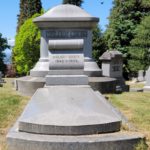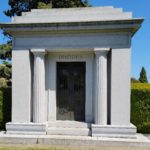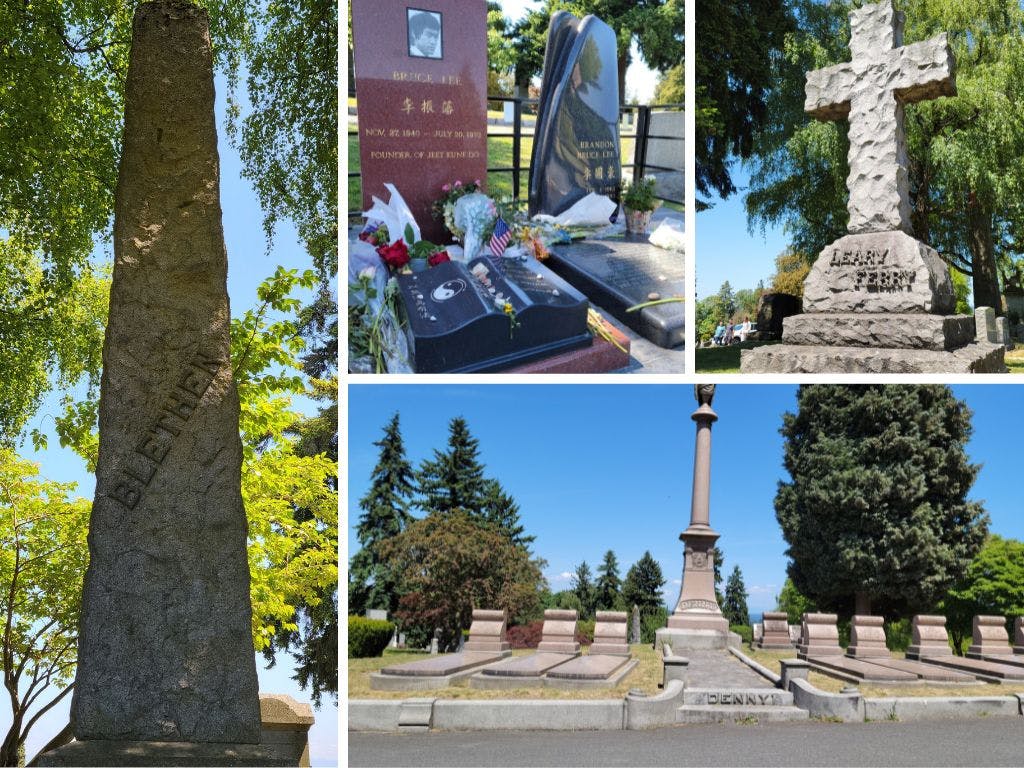Ancient pine, elm, cedar and fir trees – even a stately redwood and sequoia – dot the pasture of green separated by ribbons of asphalt. The landscape is both high and hilly, discreet and decadant. Their occupants, each with their unique life stories, rest in peace at Seattle’s longest-running burial ground.
Lake View Cemetery, spread atop one of the city’s highest points at 435 ft. above sea level, covers 38 acres on North Capitol Hill. Its views to the East offer a vista of the Olympic mountains and peeks of Lake Washington that possibly would have been more majestic when the cemetery opened in 1873 as one of the city’s first graveyards. (Before becoming Denny Park, the grounds were used for about two decades as the city’s first burial ground; the graves were exhumed in 1884 and laid to rest elsewhere.)
The occupants are a Who’s Who of Seattle history: Colman, Denny, Kinnear, McGilvra and Terry – all pioneers who helped write this city’s early chapters. Bell, Boren, Mercer and Meydenbauer, too, call Lake View home.
Alden Blethen rests on a plateau marked by a towering stone monument, he of the famed Seattle (Daily) Times Blethen family and where he worked as editor-in-chief for two decades until his death in 1915, age 69. Fellow publisher David Higgins of Seattle’s Daily Intelligencer has a simpler, yet dignified, monument only a newpaper carrier’s toss away.
Going back to the very beginning, the grounds were ceded by the original inhabitants to the territorial government in January 1855 as part of a massive land grab from dozens of Native American tribes, including Chief Sealth (roughly pronounced “Seattle”) of the Suquamish and Duwamish tribes. The first recorded land use by the newly arrived white settlers was to establish a proper cemetery.
The original entrance to the grounds was along the first wagon road from downtown into what was known as Broadway Hill. The road entered from the south side on what we call 14th Avenue East today – well before it was known as “Millionaires Row.” The entrance was moved to what is now 15th Avenue East near East Garfield Street after the development of Volunteer Park just to the south in the late 1880s.
The cemetery took its “Lake View” moniker in 1890, well before housing development and trees became stately old growths. About 10 years later, the neighborhood was renamed “Capitol Hill” by the chief land developer, James Moore, who wanted to honor his wife’s hometown of Denver, which already had a Capitol Hill.
Perhaps it is comforting to know that both the original settlers and first inhabitants share these grounds. Lake View is the home of Chief Sealth’s daughter, Kikisoblu, better known as Princess Angeline. She is laid to rest under a rough-hewn marker paid for by the pennies of Seattle school children. Her coffin was apparently constructed in the shape of a canoe and her body wrapped in a traditional Indian blanket.
David “Doc” Maynard was the city’s first physician and justice of the peace. A dear friend of the Indigenous Peoples, Maynard was believed to be one of the first burials upon his death in 1873. Maynard and his second wife Catherine had owned the land around Lake View until 1872 when the cemetery was formally established. A new headstone was installed in 2003 atop the Maynard gravesite after the original marker became weathered. Catherine’s tombstone curiously reads: “She did what she could.”
Henry Yesler, who made his money in lumber, is resting on a western hillside within close view of Princess Angeline, who asked to be entombed near her friend. Buried here, too, is Mary Ann Conklin, better known as Madame Damnable, who ran the city’s first brothel in a Pioneer Square hotel that she managed.
Many political leaders call Lake View their final resting place. They include at least 10 Seattle mayors (Yesler included), two U.S. senators and two Congressmen, as well as our state’s first governor, Elisha Ferry, who died in 1895 at age 70.
James Osborne can probably take claim for having the most elaborate gravesite. The Seattle saloonkeeper donated $20,000 to the city to build its first great hall, the Civic Auditorium, where McCaw Hall is approximately located today. The burial site for Osborne includes a 29-foot marble column, believed to be the cemetery’s tallest.
 In addition to having a catchy name, Melody Choir was a man of different hats. Legally known as Joseph Calentine, Choir compiled the city’s first directories, annual publications that started in 1878. He went through a lot of business cards, first calling himself a book agent, then a real estate dealer before changing his specialty to “capitalist.” Choir even had a stint as the city’s parks commissioner all while he made good money buying vacant city lots for less than $5 each before selling them decades later collectively for many thousands. Maybe his title should have been “opportunist.” Choir’s burial site is a true monument to his success.
In addition to having a catchy name, Melody Choir was a man of different hats. Legally known as Joseph Calentine, Choir compiled the city’s first directories, annual publications that started in 1878. He went through a lot of business cards, first calling himself a book agent, then a real estate dealer before changing his specialty to “capitalist.” Choir even had a stint as the city’s parks commissioner all while he made good money buying vacant city lots for less than $5 each before selling them decades later collectively for many thousands. Maybe his title should have been “opportunist.” Choir’s burial site is a true monument to his success.
Sports heroes chose Lake View, including Jeff Heath, a 13-year Major League Baseball player and Canadian Hall of Famer from the World War II era. Eleven-time NBA champion Bill Russell, who coached our Sonics for four seasons before retiring to Mercer Island, was laid to rest here in 2022. A marker at the foot of his gravesite simply reads: “I’ll decide.”
 Albert Rhodes is here. He was the oldest of four brothers who established a chain of popular Seattle-area department stores, simply called Rhodes, including one at 2nd Avenue and Union Street. Albert and wife Harriet are entombed in a large mausoleum that features cement columns, metal doors and distinctive Greek meander design etched along the top. He died, at 56 of the flu, while in New York City representing the Seattle Chamber of Commerce. The Rhodes had no children. Their “dependents” were said to be the hundreds of store employees.
Albert Rhodes is here. He was the oldest of four brothers who established a chain of popular Seattle-area department stores, simply called Rhodes, including one at 2nd Avenue and Union Street. Albert and wife Harriet are entombed in a large mausoleum that features cement columns, metal doors and distinctive Greek meander design etched along the top. He died, at 56 of the flu, while in New York City representing the Seattle Chamber of Commerce. The Rhodes had no children. Their “dependents” were said to be the hundreds of store employees.
The world-renowned martial artist Bruce Lee and his fellow-actor son Brandon lay side-by-side on the hill. From up high on the slope with vistas of mountains and water, the Lees look down only feet away from the burial site of Charlie Woo, one of Bruce’s earliest martial arts students who died tragically from a kick to the head by a horse.
To be sure, the Indigenous Peoples had the area’s first burials but Lake View takes the honor of most prestigious for its vistas, peaceful and manicured grounds, and melting pot of this area’s earliest habitants.
This is a solemn ground. A majestic perch overlooking the beauty of the Pacific Northwest. And in peace, they rest being remembered as pioneers, heroes, characters and common folk to our city’s great history.




